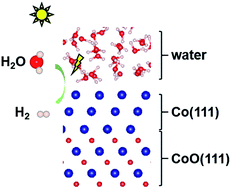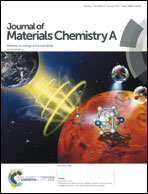Photocatalytic hydrogen evolution activity of Co/CoO hybrid structures: a first-principles study on the Co layer thickness effect†
Abstract
Both metal and semiconductor nanoparticles can induce water splitting in response to light but in different ways: metal nanoparticles can generate hot carriers with a surface plasmon resonance (SPR) effect and semiconductor nanoparticles with optimal band gap and band edges are light absorbers for hydrogen and oxygen evolution reactions (HER and OER). Hence, hybrid structures of metals and semiconductors have been anticipated to have enhanced photocatalytic activities compared to pure metals and semiconductors. To find an optimal hybrid structure for the photocatalytic HER in water splitting, we herein construct Co/CoO hybrid structures with variation of the Co layer thickness, using density functional theory (DFT) calculations. It is found that the Co/CoO hybrid structures have different electronic characteristics with respect to the Co layer thickness, which leads to the varied photocatalytic activities. Based on this study, we find out the optimal Co layer thickness for the highest HER activity. For the SPR effect, a thick enough Co layer is necessary, while a thin enough Co layer is required for optimal light absorption for the HER in solar-driven water splitting. We believe that this thorough study on the photo-responses occurring in Co/CoO heterojunction systems can be considered as a framework to design new photocatalytic metal/semiconductor heterojunction systems with first-principles studies.



 Please wait while we load your content...
Please wait while we load your content...